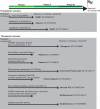Hepatitis C virus and vaccine development
- PMID: 25635247
- PMCID: PMC4293608
Hepatitis C virus and vaccine development
Abstract
The prevalence of Hepatitis C virus (HCV) is approximately 3% around the world. This virus causes chronic hepatitis, liver cirrhosis and hepatocellular carcinoma. The effectiveness of interferon-α and ribavirin therapy is about 50% and is associated with significant toxicity and cost. Hence, generating new vaccines or drugs is an obligation. However, there is no vaccine available for clinical use. DNA vaccines have some advantages such as producing feasibility and generating intensive cellular and humoral immune responses. Activation and improvement of natural immune defense mechanisms is a necessity for the development of an effective HCV vaccine. This article discusses the current status of therapies for hepatitis C, the promising new therapies and the experimental strategies to develop an HCV vaccine.
Keywords: DNA vaccine; HCV; IFN- α; cellular immune response.
Figures


Similar articles
-
Prospects for hepatitis C vaccine.Acta Virol. 2004;48(4):215-21. Acta Virol. 2004. PMID: 15745044 Review.
-
DNA vaccine expressing the non-structural proteins of hepatitis C virus diminishes the expression of HCV proteins in a mouse model.Vaccine. 2013 Dec 5;31(50):5968-74. doi: 10.1016/j.vaccine.2013.10.037. Epub 2013 Oct 19. Vaccine. 2013. PMID: 24144476
-
Methods to Evaluate Novel Hepatitis C Virus Vaccines.Methods Mol Biol. 2016;1403:221-44. doi: 10.1007/978-1-4939-3387-7_11. Methods Mol Biol. 2016. PMID: 27076133
-
Hepatitis C virus: molecular biology & current therapeutic options.Indian J Med Res. 2010 Jan;131:17-34. Indian J Med Res. 2010. PMID: 20167971 Review.
-
A Multiantigenic DNA Vaccine That Induces Broad Hepatitis C Virus-Specific T-Cell Responses in Mice.J Virol. 2015 Aug;89(15):7991-8002. doi: 10.1128/JVI.00803-15. Epub 2015 May 27. J Virol. 2015. PMID: 26018154 Free PMC article.
Cited by
-
Combating the wrath of viral hepatitis in India.Indian J Med Res. 2016 Jul;144(1):1-5. doi: 10.4103/0971-5916.193275. Indian J Med Res. 2016. PMID: 27834318 Free PMC article. No abstract available.
-
Tackling the Hepatitis C Disease Burden in Punjab, India.J Clin Exp Hepatol. 2016 Sep;6(3):224-232. doi: 10.1016/j.jceh.2016.09.005. Epub 2016 Sep 7. J Clin Exp Hepatol. 2016. PMID: 27746619 Free PMC article. Review.
-
Viral hepatitis: Indian scenario.Med J Armed Forces India. 2016 Jul;72(3):204-10. doi: 10.1016/j.mjafi.2016.06.011. Epub 2016 Aug 9. Med J Armed Forces India. 2016. PMID: 27546957 Free PMC article.
-
Cross-Reactive Effects of Vaccines: Heterologous Immunity between Tetanus and Chlamydia.Vaccines (Basel). 2020 Dec 1;8(4):719. doi: 10.3390/vaccines8040719. Vaccines (Basel). 2020. PMID: 33271962 Free PMC article.
-
Humanized Mouse Models for the Study of Hepatitis C and Host Interactions.Cells. 2019 Jun 17;8(6):604. doi: 10.3390/cells8060604. Cells. 2019. PMID: 31213010 Free PMC article. Review.
References
-
- Forns X, Bukh J, Purcell RH. The challenge of developing a vaccine against hepatitis C virus. J Hepatol. 2002;37:684–95. - PubMed
-
- Drazan KE. Molecular biology of hepatitis C infection. Liver Transpl. 2000;6:396–406. - PubMed
-
- Salomon JA, Weinstein MC, Hammitt JK, et al. Cost-effectiveness of treatment for chronic hepatitis C infection in an evolving patient population. JAMA. 2003;290:228–37. - PubMed
Publication types
LinkOut - more resources
Full Text Sources
